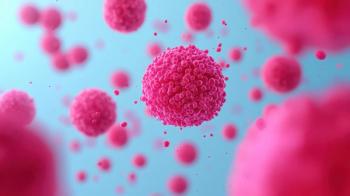
Researchers Strengthen HIV-1 Antibody, Presenting New Options for Vaccine
Some HIV antibody variants, which had mutations concentrated in antibody framework regions, achieved up to 37% neutralization breadth compared to 28% neutralization in the unmodified antibody.
By analyzing antibody responses against 208 different HIV strains, researchers at the University of Kansas were able to boost the antibody response, potentially paving the way for HIV vaccine development.
The ability of HIV-1 to quickly mutate in diverse variants is one of the major obstacles in the development of a vaccine, according to a press release. Although tremendous progress has been made in recent years, investigators are still trying to understand the best approach for a potential vaccine.
“AIDS vaccine development has been a decades-long challenge partly because our immune systems have difficulty recognizing all the diverse variants of the rapidly mutating HIV virus, which is the cause of AIDS,” said Brandon DeKosky, PhD, assistant professor of pharmaceutical chemistry and chemical & petroleum engineering at the University of Kansas, in the press release.
One of the most important developments in the past 5 years was the discovery of the vFP16.02 antibody by investigators at the National Institute of Allergy and Infectious Disease’s Vaccine Research Center. They determined that when stimulated by a vaccine, the antibody had potential to effectively fight HIV-1.
To further understand this antibody as the basis for an eventual vaccine against HIV-1, the authors of the current study partnered with the Immune Engineering Laboratory at the University of Kansas School of Pharmacy. DeKosky and his colleagues set about understanding how the same antibody-based approaches could be even more powerful in the fight against diverse HIV antigens.
They found several important mechanistic features about immune protection, including the binding strength of the antibody directly correlated to its ability to neutralize HIV-1. With this understanding, the team began attempting to increase the potency of vFP16.02.
“We wanted to see whether we could further increase the potency and neutralization breadth of this antibody,” said co-lead author Bharat Madan, a postdoctoral researcher in the DeKosky lab, in the press release. “That means you could give a lower amount of antibody to someone as a prophylaxis, and it’s going to produce a much better and broader immune response. There are various clades of HIV viruses—now I thank you must be hearing about various versions of SARS-CoV-2 like the UK variant and the South African variant—likewise, HIV also is quite diverse.”
The team used high-throughput screening platforms based on modified yeast cells to display antibody variant proteins and advanced cell sorting and next-generation DNA sequencing to explore a massive library of potential alterations to the vFP16.02 antibody. They analyzed the antibodies’ response against 208 different HIV strains and determined the features associated with antibody improvement or fitness.
“In this study, Bharat and colleagues made artificial pathways of anti-HIV-1 immune responses to identify what does and does not work for achieving better protection against HIV-1,” DeKosky said in the press release. “The results were a bit surprising and showed that the pathway to effective HIV-1 protection might be much shorter than we previously thought.”
The most effective variants in the library boosted the ability of vFP16.02 to recognize and bind to both soluble fusion peptides and the full HIV-1 envelope protein that is involved in viral entry of host cells, according to the study authors. These variants, which had mutations concentrated in antibody framework regions, achieved up to 37% neutralization breadth compared to 28% neutralization in the unmodified antibody.
Although these findings will not immediately result in a vaccine, they could point the way forward for vaccines that would protect against an array of HIV-1 variants.
“The study does a deep dive into the mechanisms of how the immune system specifically recognized HIV-1 in ways that lead to protective benefits,” DeKosky said in the press release. “It reveals some of the key insights in how to best target HIV-1 proteins in the next generation of vaccine designs.”
REFERENCE
Researchers Boost the Potency of an HIV-1 Antibody, Tracing New Potential Pathways for Vaccine Development [news release]. University of Kansas; March 11, 2021.
Newsletter
Stay informed on drug updates, treatment guidelines, and pharmacy practice trends—subscribe to Pharmacy Times for weekly clinical insights.





















































































































































































































